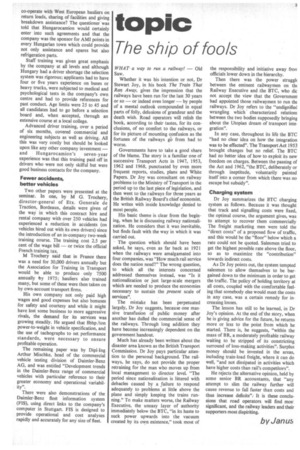topic
Page 33

If you've noticed an error in this article please click here to report it so we can fix it.
The ship of fools
WHATa way to run a railway! — Old Saw.
Whether it was his intention or not, Dr Stewart Joy, in his book The Train That Ran Away, gives the impression that the railways have been run for the last 30 years or so — or indeed even longer — by people of a mental outlook compounded in equal parts of folly, delusions of grandeur and the death wish. Road operators will relish the book, according to their tastes, for its conclusions, of no comfort to the railways, or for its picture of mounting confusion as the fortunes of the railways go from bad to worse.
Governments have to take a good share of the blame. The story is a familiar one of successive Transport Acts in 1947, 1953, 1962 and 1968, punctuated by even more frequent reports, studies, plans and White Papers. Dr Joy was consultant on railway problems to the Ministry of Transport in the period up to the last piece of legislation, and then went to the railways for three years as the British Railway Board's chief economist. He writes with inside knowledge denied to most people.
His basic theme is clear from the begining, when he is discussing railway nationalization. He considers that it was inevitable, but finds fault with the way in which it was carried out.
The question which should have, been asked, he says, even as far back as 1921 when the railways were amalgamated into four companies, was "How much rail service does the nation need?" The wrong question, to which all the interests concerned addressed themselves instead, was "Is it nationalization or just large-scale mergers which are needed to produce the economies necessary to sustain the present scale of services".
The mistake has been perpetuated largely, Dr Joy suggests, because one massive transfusion of public money after another has dulled the commercial sense of the railways. Through long addition they have become increasingly dependent on the government handout.
Much has already been written about the disaster area known as the British Transport Commission. Dr Joy pays particular attention to the personal background. The railways, he says, do not provide the proper retraining for the man who moves up from local management to director level. "The period since nationalization is littered with debacles caused by a failure to respond adequately to problems at little above the plane and simply keeping the trains running." To make matters worse, the Railway Executive, the uneasy layer of authority immediately below the BTC, "in its haste to suck power upwards into the vacuum created by its own existence," took most of the responsibility and initiative away fron officials lower down in the hierarchy.
Then there was the power struggh between the eminent railwaymen on flu Railway Executive and the BTC, who clic not accept the view that the Governrnern had appointed those railwaymen to run tilt railways. Dr Joy refers to the "undignified wrangling which characterized relations between the two bodies supposedly bringing about the Utopian dream of transport integration".
In any case, throughout its life the BTC "had no clear idea on how the integration was to be effected". The Transport Act 1953 brought changes but no relief. The BTC had no better idea of how to exploit its new freedom on charges. Between the passing of the Act and 1962, "the BTC, deliberately or through ineptitude, voluntarily painted itself into a corner from which there was no escape but subsidy".
Charging system
Dr Joy summarizes the BTC charging system as follows. Because it was thought that track and signalling costs were fixed, the optimal course, the argument gives, was to attempt to recover them commercially The freight marketing men were told the "direct costs" of a proposed flow of traffic, and this would be the "floor" below which a rate could not be quoted. Salesmen tried to get the highest possible rate above the floor, so as to maximize the "contribution" towards indirect costs.
As Dr Joy points out, the system tempted salesmen to allow themselves to be bargained down to the minimum in order to get the traffic. The policy of holding territory at all costs, coupled with the comfortable feeling that somebody else would meet the costs in any case, was a certain remedy for increasing losses.
The lesson has still to be learned, in Dr Joy's opinion. At the end of the story, when he is giving advice for the future, he returns more or less to the point from which he started. There is, he suggests, "within the mass of BR, a moderately profitable railway waiting to be stripped of its constricting surround of loss-making activities". Surplus money should be invested in the areas, including train-load freight, where it can do well, "and not dissipated in activities which have higher costs than rail's competitors".
He rejects the alternative opinion, held by some senior BR accountants, that "any attempt to slim the railway further will cause revenue to fall faster than costs and thus increase deficits": It is these conclusions that road operators will find mos' significant, and the railway leaders and their supporters most dispiriting.
by Janus




































































































